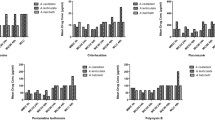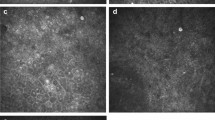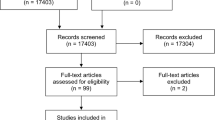Abstract
Purpose
To compare the efficacy of topical voriconazole 1% and the combination therapy of 0.02% polyhexamethylene biguanide (PHMB) and 0.02% chlorhexidine for the treatment of Acanthamoeba keratitis (AK).
Methods
This is a prospective, pilot, double-masked randomized comparative study. Twenty-three eyes of 23 patients with microbiologically (smear and/or growth on culture) confirmed AK were randomized to group BG (PHMB 0.02% and chlorhexidine 0.02%) or group VZ (voriconazole 1%). Primary outcome measure was change in geometric mean (GM) of the corneal ulcer size at final visit. Secondary outcome measures were change in visual acuity.
Results
Out of 71 patients with confirmed AK seen during study period, 23 patients were recruited and 18 patients completed minimum 2 weeks of treatment and further analyzed. Ten patients received BG, whereas eight received VZ. Median ulcer size measured as GM of infiltrate decreased from 5.7 mm (IQR, 5.3–6.5 mm) (p = 0.02) to 1 mm (IQR, 0–4.3 mm) in group BG and from 4.5 mm (IQR, 1.8–5.1 mm) (p < 0.05) to 0.7 mm (IQR, 0–1.6 mm) in VZ group. Median visual acuity improved from 1.79 (IQR, 1.48–2.78) to 1.10 (IQR, 0.48–1.79) in BG group (p = 0.02) and from 1.60 (IQR, 1.00–2.78) to 0.80 (IQR, 0.48–1.30) in VZ group (p = 0.18).
Conclusion
These outcomes suggest that topical VZ as a monotherapy in AK treatment is effective and comparable to BG combination therapy but needs trials with larger sample size and longer follow-up to provide conclusive evidence.
Similar content being viewed by others
Log in or create a free account to read this content
Gain free access to this article, as well as selected content from this journal and more on nature.com
or
References
Carnt N, Robaei D, Minassian DC, Dart JKG. Acanthamoeba keratitis in 194 patients: risk factors for bad outcomes and severe inflammatory complications. Br J Ophthalmol. 2018;102:1431–35.
Dart JK, Saw VP, Kilvington S. Acanthamoeba keratitis: diagnosis and treatment update 2009. Am J Ophthalmol. 2009;148:487–99 e2.
Sharma S, Garg P, Rao GN. Patient characteristics, diagnosis, and treatment of non-contact lens related Acanthamoeba keratitis. Br J Ophthalmol. 2000;84:1103–8.
Tirado-Angel J, Gabriel MM, Wilson LA, Ahearn DG. Effects of polyhexamethylene biguanide and chlorhexidine on four species of Acanthamoeba in vitro. Curr Eye Res. 1996;15:225–8.
Narasimhan S, Madhavan HN, K LT. Development and application of an in vitro susceptibility test for Acanthamoeba species isolated from keratitis to polyhexamethylene biguanide and chlorhexidine. Cornea. 2002;21:203–5.
Schuster FL, Guglielmo BJ, Visvesvara GS. In-vitro activity of miltefosine and voriconazole on clinical isolates of free-living amebas: Balamuthia mandrillaris, Acanthamoeba spp., and Naegleria fowleri. J Eukaryot Microbiol. 2006;53:121–6.
Ehlers N, Hjortdal J. Are cataract and iris atrophy toxic complications of medical treatment of acanthamoeba keratitis? Acta Ophthalmol Scand. 2004;82:228–31.
Herz NL, Matoba AY, Wilhelmus KR. Rapidly progressive cataract and iris atrophy during treatment of Acanthamoeba keratitis. Ophthalmology. 2008;115:866–9.
Duguid IG, Dart JK, Morlet N, Allan BD, Matheson M, Ficker L, et al. Outcome of acanthamoeba keratitis treated with polyhexamethyl biguanide and propamidine. Ophthalmology. 1997;104:1587–92.
Illingworth CD, Cook SD. Acanthamoeba keratitis. Surv Ophthalmol. 1998;42:493–508.
Awwad ST, Parmar DN, Heilman M, Bowman RW, McCulley JP, Cavanagh HD. Results of penetrating keratoplasty for visual rehabilitation after Acanthamoeba keratitis. Am J Ophthalmol. 2005;140:1080–4.
Parthasarathy A, Tan DT. Deep lamellar keratoplasty for acanthamoeba keratitis. Cornea. 2007;26:1021–3.
Aichelburg AC, Walochnik J, Assadian O, Prosch H, Steuer A, Perneczky G, et al. Successful treatment of disseminated Acanthamoeba sp. infection with miltefosine. Emerg Infect Dis. 2008;14:1743–6.
Bagga B, Garg P, Joseph J, Mohamed A, Kalra P. Outcome of therapeutic deep anterior lamellar keratoplasty in advanced Acanthamoeba keratitis. Indian J Ophthalmol. 2020;68:442–6.
Kaiserman I, Bahar I, McAllum P, Srinivasan S, Elbaz U, Slomovic AR, et al. Prognostic factors in Acanthamoeba keratitis. Can J Ophthalmol. 2012;47:312–7.
Walochnik J, Obwaller A, Gruber F, Mildner M, Tschachler E, Suchomel M, et al. Anti-acanthamoeba efficacy and toxicity of miltefosine in an organotypic skin equivalent. J Antimicrob Chemother. 2009;64:539–45.
Tu EY, Joslin CE, Shoff ME. Successful treatment of chronic stromal acanthamoeba keratitis with oral voriconazole monotherapy. Cornea. 2010;29:1066–8.
Gupta S, Shrivastava RM, Tandon R, Gogia V, Agarwal P, Satpathy G. Role of voriconazole in combined acanthamoeba and fungal corneal ulcer. Cont Lens Anterior Eye. 2011;34:287–9.
Polat ZA, Obwaller A, Vural A, Walochnik J. Efficacy of miltefosine for topical treatment of Acanthamoeba keratitis in Syrian hamsters. Parasitol Res. 2012;110:515–20.
Cabello-Vilchez AM, Martin-Navarro CM, Lopez-Arencibia A, Reyes-Batlle M, Sifaoui I, Valladares B, et al. Voriconazole as a first-line treatment against potentially pathogenic Acanthamoeba strains from Peru. Parasitol Res. 2014;113:755–9.
Martin-Navarro CM, Lopez-Arencibia A, Sifaoui I, Reyes-Batlle M, Valladares B, Martinez-Carretero E, et al. Statins and voriconazole induce programmed cell death in Acanthamoeba castellanii. Antimicrob Agents Chemother. 2015;59:2817–24.
Rocha-Cabrera P, Reyes-Batlle M, Martin-Navarro CM, Dorta-Gorrin A, Lopez-Arencibia A, Sifaoui I, et al. Detection of Acanthamoeba on the ocular surface in a Spanish population using the Schirmer strip test: pathogenic potential, molecular classification and evaluation of the sensitivity to chlorhexidine and voriconazole of the isolated Acanthamoeba strains. J Med Microbiol. 2015;64:849–53.
Bang S, Edell E, Eghrari AO, Gottsch JD. Treatment with voriconazole in 3 eyes with resistant Acanthamoeba keratitis. Am J Ophthalmol. 2010;149:66–9.
Hou TY, Chen YC, Hsu CC. Rapid resolution of stromal keratitis with the assistance of oral voriconazole in resistant acanthamoeba keratitis. Taiwan J Ophthalmol. 2017;7:224–6.
Whitehead AL, Julious SA, Cooper CL, Campbell MJ. Estimating the sample size for a pilot randomised trial to minimise the overall trial sample size for the external pilot and main trial for a continuous outcome variable. Stat Methods Med Res. 2016;25:1057–73.
Browne RH. On the use of a pilot sample for sample size determination. Stat Med. 1995;14:1933–40.
Wang YE, Tepelus TC, Vickers LA, Baghdasaryan E, Gui W, Huang P, et al. Role of in vivo confocal microscopy in the diagnosis of infectious keratitis. Int Ophthalmol. 2019;39:2865–74.
Jabs DA, Nussenblatt RB, Rosenbaum JT. Standardization of Uveitis Nomenclature Working G. Standardization of uveitis nomenclature for reporting clinical data. Results of the First International Workshop. Am J Ophthalmol. 2005;140:509–16.
Laidlaw DA, Tailor V, Shah N, Atamian S, Harcourt C. Validation of a computerised logMAR visual acuity measurement system (COMPlog): comparison with ETDRS and the electronic ETDRS testing algorithm in adults and amblyopic children. Br J Ophthalmol. 2008;92:241–4.
Garg P, Kalra P, Joseph J. Non-contact lens related Acanthamoeba keratitis. Indian J Ophthalmol. 2017;65:1079–86.
Pearson MM, Rogers PD, Cleary JD, Chapman SW. Voriconazole: a new triazole antifungal agent. Ann Pharmacother. 2003;37:420–32.
Sharma N, Sahay P, Maharana PK, Singhal D, Saluja G, Bandivadekar P, et al. Management algorithm for fungal keratitis: the TST (Topical, Systemic, and Targeted Therapy) protocol. Cornea. 2019;38:141–5.
Gueudry J, Le Goff L, Compagnon P, Lefevre S, Colasse E, Aknine C, et al. Evaluation of voriconazole anti-Acanthamoeba polyphaga in vitro activity, rat cornea penetration and efficacy against experimental rat Acanthamoeba keratitis. J Antimicrob Chemother. 2018;73:1895–8.
Talbott M, Cevallos V, Chen MC, Chin SA, Lalitha P, Seitzman GD, et al. Synergy testing of antiamoebic agents for acanthamoeba: antagonistic effect of voriconazole. Cornea. 2019;38:1309–13.
Sunada A, Kimura K, Nishi I, Toyokawa M, Ueda A, Sakata T, et al. In vitro evaluations of topical agents to treat Acanthamoeba keratitis. Ophthalmology. 2014;121:2059–65.
Levine MT, Chandrasekar PH. Adverse effects of voriconazole: over a decade of use. Clin Transplant. 2016;30:1377–86.
Lau D, Fedinands M, Leung L, Fullinfaw R, Kong D, Davies G, et al. Penetration of voriconazole, 1%, eyedrops into human aqueous humor: a prospective open-label study. Arch Ophthalmol. 2008;126:343–6.
Funding
This study was funded by Hyderabad eye research foundation.
Author information
Authors and Affiliations
Corresponding author
Ethics declarations
Conflict of interest
The authors declare that they have no conflict of interest.
Additional information
Publisher’s note Springer Nature remains neutral with regard to jurisdictional claims in published maps and institutional affiliations.
Rights and permissions
About this article
Cite this article
Bagga, B., Sharma, S., Gour, R.P.S. et al. A randomized masked pilot clinical trial to compare the efficacy of topical 1% voriconazole ophthalmic solution as monotherapy with combination therapy of topical 0.02% polyhexamethylene biguanide and 0.02% chlorhexidine in the treatment of Acanthamoeba keratitis. Eye 35, 1326–1333 (2021). https://doi.org/10.1038/s41433-020-1109-4
Received:
Revised:
Accepted:
Published:
Issue date:
DOI: https://doi.org/10.1038/s41433-020-1109-4
This article is cited by
-
Response to ‘Comment on: ‘A randomized masked pilot clinical trial to compare the efficacy of topical 1% Voriconazole ophthalmic solution as monotherapy to combination therapy with topical 0.02% Polyhexamethylene biguanide and 0.02% Chlorhexidine in the treatment of Acanthamoeba keratitis’’
Eye (2022)
-
Comment on: ‘A randomized masked pilot clinical trial to compare the efficacy of topical 1% voriconazole ophthalmic solution as monotherapy with combination therapy of topical 0.02% polyhexamethylene biguanide and 0.02% chlorhexidine in the treatment of Acanthamoeba keratitis’
Eye (2022)
-
Update on the Management of Acanthamoeba Keratitis
Current Ophthalmology Reports (2022)



